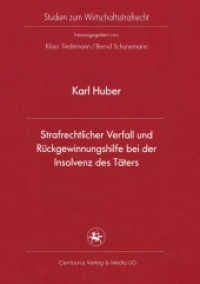- ホーム
- > 洋書
Full Description
Phishing Detection Using Content-Based Image Classification is an invaluable resource for any deep learning and cybersecurity professional and scholar trying to solve various cybersecurity tasks using new age technologies like Deep Learning and Computer Vision. With various rule-based phishing detection techniques at play which can be bypassed by phishers, this book provides a step-by-step approach to solve this problem using Computer Vision and Deep Learning techniques with significant accuracy.
The book offers comprehensive coverage of the most essential topics, including:
Programmatically reading and manipulating image data
Extracting relevant features from images
Building statistical models using image features
Using state-of-the-art Deep Learning models for feature extraction
Build a robust phishing detection tool even with less data
Dimensionality reduction techniques
Class imbalance treatment
Feature Fusion techniques
Building performance metrics for multi-class classification task
Another unique aspect of this book is it comes with a completely reproducible code base developed by the author and shared via python notebooks for quick launch and running capabilities. They can be leveraged for further enhancing the provided models using new advancement in the field of computer vision and more advanced algorithms.
Contents
Chapter 1. Phishing and Cybersecurity. Basics of Phishing in Cybersecurity. Phishing Detection Techniques. List (whitelist/blacklist) based. Heuristics (pre-defined rules) based. Visual similarity based. Race between Phishers and Anti-Phishers. Chapter 2. Image Processing based Phishing Detection Techniques. Image processing based phishing detection techniques. Challenges in Phishing Detection using website images. Comparison of Techniques. Summary of Phishing detection using image processing techniques. Chapter 3. Implementing CNN for classifying phishing websites. Data Selection and Pre-Processing. Classification using CNN. CNN implementation. Performance metrics. Building a Convolutional Neural Network Model. Chapter 4. Transfer Learning Approach in Phishing Detection. Classification using Transfer Learning. Transfer Learning python implementation. Performance assessment of CNN models. Chapter 5. Feature Extraction and Representation Learning. Classification using Representation Learning. Data Preparation.. Feature Extraction using CNN off-the-shelf architectures. Handling class imbalance using SMOTE. SMOTE python implementation. Machine learning Classifier. Performance assessment of various experimentations. Chapter 6. Dimensionality Reduction Techniques. Basics of dimensionality reduction. PCA implementation using python. Performance assessment of various experimentations. Chapter 7. Feature Fusion Techniques. Basics of feature fusion technique. Different combinations of image representations. Different feature fusion approaches. Performance assessment of various experimentations. Chapter 8. Comparison of Phishing detection approaches. Classification Approaches. Evaluation of Classification Experiments. Comparison of the best performing model with the State-of-the-art. Chapter 9. Basics of Digital Image Processing. Basics of digital image processing. Basics of extracting features using OpenCV.






